|
Archive of Past Artist - for reference only At the close of the 2017 Season, Both North Rim and South Rim AiR Programs will be been suspended indefinitely. You may check this webpage periodically for updated information. If you have further questions, you may email us at GRCA_AiR@nps.gov 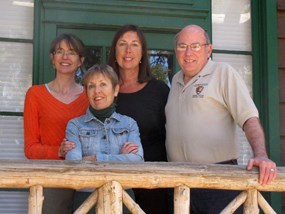
2010 Jury Panel Meet the Jury Panel!
Kim Buchheit: Grand Canyon, AZ. With over 20 years of experience in design, Kim’s creative services include surface design patterns, illustration, graphic design, exhibit and website design. Clients include retail clothing companies, non-profit organizations, children – and youth- focused businesses and national parks. Kim is also a mixed-media studio artist and serves frequently as a juror for regional festivals and exhibits. Claire West: Phoenix, AZ. Claire is an independent consultant in the arts and non-profit management, who serves on the boards of Grand Canyon Music Festival, Arizona School for the Arts, and VSA Arizona. Claire also serves on the advisory committees for The School of Ballet Arizona, and Arizona Music & Entertainment Hall of Fame. She is the booking manager for classical musicians Brad Richter and Viktor Uzur, and is Officer of Corporate, Foundation and Government Relations for the Children's Museum of Phoenix. Claire previously served as the Business Manager for School of Ballet Arizona, and was the Performing Arts Director at the Arizona Commission on the Arts for 17 years.
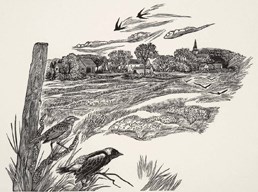
Wood Engraving by Siri Beckman Relief printmaker and painter Siri Beckman is the October 2010 artist-in-residence. Siri lives in Stonington, Maine and holds her BA in Art History from Lake Forest College, Illinois and her MFA in Book Arts and Printmaking from the University of the Arts in Philadelphia, Pennsylvania. She has taught workshops in book arts and printmaking at the prestigious Haystack Mountain School of Craft in Deer Isle, Maine, and has taught both as an artist-in-residence and at the University level. She is an experienced artist-in-residence for the National Parks including Acadia National Park, Bar Harbor, Maine (1997), Rocky Mountain National Park, Estes Park, Colorado (2000), Badlands National Park, Interior, South Dakota (2002) and Hovenweep National Monument, Cortez, Colorado (2003). Siri's prints can be seen in several publications including A Week at the Lake by Grace Butterfield Dow (Down East Books, Camden, ME, 2001). Her work is in both private and public collections including Boston Public Library's Rare Books and Manuscripts and the Portland (Maine) Museum of Art. Siri is a member of Stonington Galleries, an association of Stonington artists. Her work can be seen at Turtle Gallery (Deer Isle, ME), Isalos Fine Art (Stonington, ME), Mulford Gallery (Rockland, ME) and William R. Talbot Fine Art (Santa Fe). Siri: "My early wood engravings were strongly influenced by my environment and daily life in the Maine fishing town of Stonington. The simple direct relief printmaking process fit my low-tech lifestyle. To be in the natural landscape has always been my greatest love. Today this is increasingly a challenge as habitat for plants and animals disappears rapidly to development. Our National Park system along with National Wildlife Refuges helps conserve crucial landscapes. During my years while working in the National Parks' artist-in-residence programs and visiting National Wildlife Refuges, I strive to synthesize the beauty of what I see in order to share my experiences with others." While in-residence, Siri will offer three demonstrations on the relatively unknown process of woodblock printing. Her own work will focus on hiking and sketching for future prints, getting some of these prints in-process, and exploring the park library and archives for evidence of past printmakers who have contributed to the park's collections and for images she might use in her work. 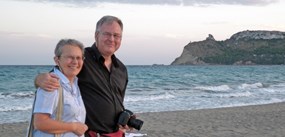
November 2010 artists-in-residence are Angela Ragusa (writer) and Bill Woolf (videographer). Angela is an Italian national who lives in Santu Lussurgiu, Italy, with husband Bill Woolf. She has her degree from the University of Florence in political science and is a much-published author of children’s books and short stories. She fluent in four languages, and is in high demand as a book translator. She has translated both adult and children’s books including works by Carl Sandburg, Joyce Carol Oates, Kate DiCamillo, Mark Helprin, and Jerry Spinelli. Her book, L’Albero delle 1000 Dolcezze was a finalist for Best Children’s Fiction book of the Year (2010) and she has won many awards for her children’s books and for her book translations. Bill, a U.S. citizen, holds a MFA in Studio Art from Florida State University, Tallahassee, Florida, and a PH.D. from Cornell University, Ithaca, New York. He was a practicing psychotherapist before art consumed all his time. Bill’s paintings have been shown internationally. Currently, he focuses on documentary videography capturing the world around him including travel adventures he shares with Angela. Bill teaches documentary video and digital photography workshops at the Institute for Italian and Sardinian Studies in Santu Lussurgiu (he is also the executive director). Before moving to Sardinia he was dean of students at an art institute in Florence (Italy). He taught drawing, figure painting, and digital photography at Florida State University, Tallahassee, and other universities. Angela: “One year ago, when my husband and I visited the Grand Canyon, staying several days and taking long hikes to better absorb its beauty, it made a strong impression on me. That was my first visit. I had read about it, and seen pictures and documentaries, but nothing could have prepared me to its majestic sheer beauty. With its air clear as transparent light at dawn and the deep silence of its starry night, its scarred cliffs red as blood at sunset, and its steep paths worn by the feet of its ancient inhabitants many centuries before the Spanish “discovered” it; the all-present singing of it’s bright-colored birds, the breath-taking deepness of its gorges, and the brown tumultuous river running at its bottom… all this seemed to me a wonderful setting for not only one, but many, many stories”. Bill: “Life can be serendipitous. You plan on painting or filming one thing and you end up doing something else because some little occurrence happens and changes your focus. In January, Angela and I went to Peru and visited Machu Picchu. We were in the middle of the flooding that eventually led to tourists being airlifted out of Aguas Calientes. As a documentary videographer, I am interested in the world around us and the people, the plants, and the animals that inhabit it. During my time as an artist-in-residence at the Grand Canyon, I plan to follow one stream, filming its beauty, its menace, and its surrounding environment of canyon, plants and wildlife. By exploring on a small scale this shaping process of water from one stream through the intimate interaction of water, geology, biology and environment, my work can show how something as beautiful and vast as the Grand Canyon became the marvel that it is.” While in residence Angela and Bill will offer one special artist talk for park visitors that will focus on their early residency inner canyon hike and how this experience may influence their future work. Additionally, each will conduct a workshop in the local school. Angela’s studio work will focus on her children’s book, Two Italian Kids in the Grand Canyon, while Bill will begin his video project on water processes in the canyon. 
acrylic painting on canvas by Rachel Wilson The December, 2010, artist-in-residence is painter and installation artist Rachel Wilson. Originally from Iowa City, Iowa, Rachel lives in Flagstaff, Arizona, her home base for regional and international artist adventures. She graduated from Pennsylvania State University with a degree in anthropology and studied art at Penn State and Shippensburg State University, as well as Northern Arizona University in Flagstaff. Rachel is a painter and monotype printmaker who recently has been creating installation art using painted and manipulated fiber and mixed materials in large-scale gallery and outdoor installations. Her work has garnered many awards including an invitation to participate in the Biennial Sculpture Exhibition in East Haddem, Connecticut and a Professional Development Grant from Arizona Commission on the Arts to attend an artist-in-residence in Mt. Bruce, New Zealand. She has shown locally, nationally and internationally as a painter and an installation artist in both solo and group shows. Rachel also teaches workshops in mixed media and monotype for both students and adults and has served as curator for exhibits in the Flagstaff and Phoenix areas. Rachel: “At the Grand Canyon, I intend to work on large, multilayered and segmented, painted fabric structures that will explore the idea of strata through time, as seen in the layering of translucent fabrics and symbolic representation. Though I have lived in Flagstaff nearly thirty years and am familiar with a good deal of the ecology and history of the Colorado Plateau, I welcome this residence opportunity to not only live with the beauty of the canyon, but also to take advantage of the park’s museum collection and research library. I hope to find interesting sources of design and ideas new and old, from archives, current literature, and conversations with staff. I intend to concentrate on developing symbols representing geologic layers, fossil forms, archeological finds, as well as modern plants and animals… not forgetting today’s park and its commercial life.” While in residence Rachel will offer two hands-on workshops in the local school and one demo workshop, printing and painting on fabric, for local adults. You can see an exhibit of her individual work as well as a small installation in the Park Headquarters from December 2 - 28, open daily from 8:00 a.m. - 5:00 p.m. In studio, Rachel will translate her local research into the beginning of a new, large-scale fabric installation.
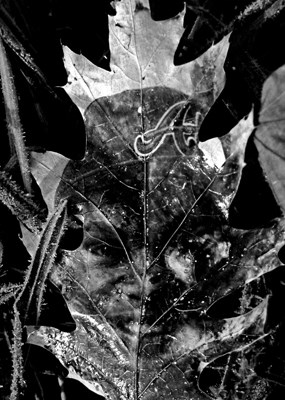
from the "Faces in Nature" installation silver gelatin photo printed on oak leaf, photographed on-site after one night's exposure to heavy frost. Pamela Petro, non-fiction writer, photographer and environmental installation artist, is the January 2011 artist-in-residence. Pamela lives in Northampton, Massachusetts, where she teaches creative writing part-time at Smith College. She holds a BA from Brown University in writing and illustration and a MA in writing from the University of Wales, UK. Pam is a much-published author, including her travel-related non-fiction books The Slow Breath of Stone: A Romanesque Love Story (Harper Collins, 2005), Sitting up with the Dead: A Storied Journey through the American South (HarperCollins, 2001) and Travels in an Old Tongue: Touring the World Speaking Welsh (HarperCollins, 1997), as well as articles and essays for The Atlantic Monthly, Bon Appetit and Ms. Magazine to name a few. Pamela is also a frequently exhibited visual artist, with solo and groups shows in the Northeast. Pamela: “My writing concentrates on art and place. My petrographs are gelatin silver images printed on stone and other organic materials. Photography has been called the process of “drawing a man’s shadow to stone.” By casting and briefly fixing our shadows to the bedrock, petrographs juxtapose the “snapshot” span of our mortal memories with the vastness of geological time. My installation method is to harvest rocks and other natural debris from rivers, beaches, forests—anywhere in the natural world—print upon them, and return them to their home environments where I photograph them over time. Subjecting images from the human realm to naturally erosive agents—from flowing water to sun, rain, and snow—reminds us of our mortal context on the earth—the place that shapes us. Grand Canyon, with its profoundly contrasting geological and human time scales and spectacular cycles of erosion and replenishment, is the ideal inspiration for my new project. I’ll be creating a series of short narratives every day while collecting overheard conversations, observed details, and science-based research snippets on geology, water and erosion. Once home, I’ll print my park-based images on stones and natural detritus to create a “graphic memoir” of my time at the canyon.” While in residence Pamela will offer an evening program featuring her visual work, a writing workshop for the local high school students, and an evening program of her literary reading. In studio, Pamela will focus on gathering components and research for her final Grand Canyon project, to be completed in her home studio. 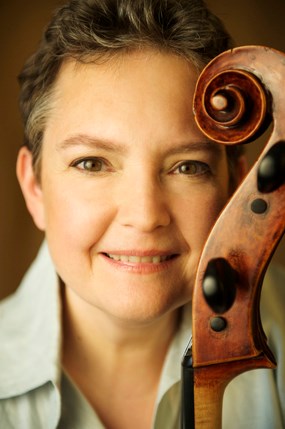
Cellist Rhonda Rider is the February 2011 artist-in-residence.
Rhonda: “As a professional cellist, my life is filled with an extraordinary variety of music— masterpieces from the past as well as the present. Works by Bach, Beethoven, and Brahms are profoundly meaningful and I consider myself fortunate to live so closely with them. Another of my great joys is working with living composers. Having the opportunity to bring a new piece to life through the exploration of fresh ideas and innovative sound worlds is tremendously exciting and rewarding. For this project I have asked ten celebrated composers to write works inspired by Grand Canyon. Each person’s experience of the canyon’s grandeur, while profoundly personal, can also bring us in touch with the universality of nature and the human experience. The highly versatile sound of the cello is a wonderful medium for this project, singing at times like a human voice and at others like an ancient instrument from another world. Composed by exceptional musicians with unique perspectives from diverse backgrounds, these pieces will undoubtedly be beautiful, moving, and extraordinary—as is Grand Canyon itself.” While in residence Rhonda will present two performances—one for the public and one for local school children. The public performance will be an evening program held on a February 26th in celebration of Grand Canyon’s 92nd anniversary of becoming a national park, and will feature both hallmarks of the cello repertoire as well as new work that Rhonda has commissioned specifically for this residency. The public school performance will focus on actively engaging the kids in amswering: What does the Grand Canyon sound like to you? Composers Yu-Hui Chang (Brandeis University); Marti Epstein (Boston Conservatory & Berklee College of Music); Howard Frazin (Longy School of Music, Cambridge, MA); Laura Kaminsky (Symphony Space, NYC), John Kennedy (Santa Fe New Music); Jeffrey Mumford (Lorain County Community College, Ohio); David Rakowski (Brandeis University); Jan Swafford (The Boston Conservatory); Andy Vores (The Boston Conservatory); Dalit Warshaw (The Boston Conservatory); Emma Lively (LivelyWorks, NYC) will contribute to the performance programs. In studio Rhonda will pursue a rigorous rehearsal schedule and spend time outside, soaking up the Grand Canyon experience. 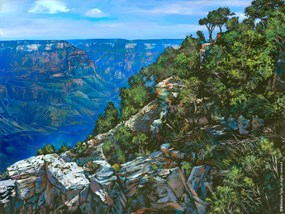
Oil painting on panel by Will Tapia Plein air painter Williamson Tapia is the March 2011 artist-in-residence. Will is from Sedona, Arizona, and holds a BFA from Arizona State University. He has participated in numerous plein-air events including the Sedona Plein Air Festival (2005-9); Estes Park, Colorado (2008); Winter Park, Colorado (2007); and most recently Grand Canyon Celebration of Art - Plein Air on the Rim (2009-10). As an Arizona-based instructor of drawing and painting, Will has been able to give back to the local arts community much of what he has learned both academically and independently about art and plein air over the last 30 years. His plein air work was recently displayed alongside celebrated western-landscape painters James Swinnerton and Maynard Dixon at the Phippen Museum’s Greatest Earth on Show (winter, 2009-10). Will: “The use of a camera or photo reference is a very practical approach to landscape painting nowadays, especially with changing weather, non-accessibility, or simply limited time constraints. Consider that there was a time when paintings were made without camera technology whatsoever, and artists had to rely completely upon a direct study of everything eye-to-subject-to-canvas. They were not able to look at a digital image during the painting process, nor were they able to consult a photograph or computer display afterwards to add and create details in-studio. What direct-study artists had to do was return to the site with materials again and again, working in recursive sessions in order to anticipate and interpret the effects of a moving [solar] light source over a series of days, until the composition was satisfactory. One only has to visit a major museum collection to see and appreciate the fruits of their labors. Today, stubborn painters like me have shunned the use of camera technology in the hopes of retaining and expounding upon aspects of what the old, pre-camera, masters did so brilliantly in the past, eye-to-subject-to-canvas. In terms of subject matter, I can imagine no better place to explore the direct-study legacy of landscape painting than at the Grand Canyon ... where the great Thomas Moran himself once walked and painted.” While in residence, Will is offering one evening program which will focus on his work and the plein air genre of landscape painting. Additionally, he will offer demonstrations on the rim, welcoming everyone to stop by to discuss his artistic endeavors. Will is planning on being outside as much as March weather will allow, working on several paintings during his residency. 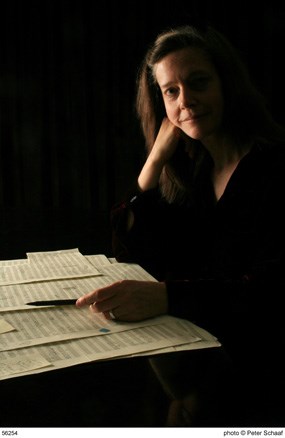
Composer and shakuhachi player Elizabeth Brown is the April 2011 artist-in-residence. Elizabeth lives in Brooklyn, New York, where she combines a successful composing career with an extremely diverse performing life, playing flute, shakuhachi (traditional Japanese bamboo flute), theremin (an early electronic musical instrument), and dan bau (Vietnamese monochord) in a wide variety of musical circles. Elizabeth received her BM from the College-Conservatory of Music at the University of Cincinnati, and her MM from The Julliard School. Her work has been widely presented nationally and internationally, both as a musician and as a composer. She has received of a Guggenheim Foundation Fellowship, has participated in other National Park Service residencies (Isle Royale, Michigan and Acadia National Park, Maine), and has participated in a five-month Japan/U.S. Friendship Commission Fellowship. Elizabeth has also collaborated with photographers on installation work and has several CDs of her solo and collaborative musical projects. Elizabeth: “Shakuhachi is a traditional Japanese bamboo flute known for evoking the sounds of nature, with a tradition of playing outdoors as a meditative practice. Its sound carries beautifully outdoors and becomes especially magical after dark, when the quality of its sound makes people listen more closely to the natural sounds around them. Building on a foundation of traditional shakuhachi repertoire, which I’ve studied for many years, I compose pieces in my own musical language. In Acadia National Park and Isle Royale National Park, local geography and birdsong shaped earlier pieces in this series. In Acadia in late summer, I traced the path of single leaves falling to create musical phrases. In Isle Royale, I was inspired by how sound moved across the water and how the park’s animals used this acoustic phenomenon to call and respond. Larger enduring geological cycles as well as the ephemeral life cycles of some plants and insects influence the rhythm and overall shape of my pieces.” While in residence, Elizabeth will offer two informal and contemplative evening concerts featuring her work with the shakuhachi (outdoors, if weather permits) and one acoustic walk, done in collaboration with a park interpretive ranger who specializes in geology. In her studio time, Elizabeth will work on her on-going series of pieces for shakuhachi, inspired by place and nature, playing with the unique geological formations and acoustical properties of Grand Canyon and natural sounds. 
Mixed media installation by Shawn Skabelund The May 2011 artist-in-residence is Shawn Skabelund, who does site-specific, place-based installation art. Shawn lives in Flagstaff, Arizona, where he is a lecturer in the School of Art at Northern Arizona University. He teaches Anatomy for Artists, Figure Drawing and Site-specific, Place-based Installation Art. He holds a BFA in drawing from Utah State University in Logan, and a MFA in drawing/painting from the University of Iowa in Iowa City. Shawn has an extensive national exhibition record, with more than 40 large-scale installations at venues throughout the U.S., 29 of which were part of solo exhibitions. He received an Individual Artist Project Grant from Arizona Commission on the Arts in 2003 and the 22nd Rosen Outdoor Sculpture Competition and Exhibition (2008), sponsored by the Turchin Center for the Visual Arts at Appalachian State University in Boone, North Carolina. Shawn: “Since 1993, I have been creating large-scale, site-specific, place-based installations that examine a variety of social and ecological issues related to the interaction between cultures and the natural landscapes that those cultures inhabit. My work explores what Wendell Berry calls the “unsettling of America,” namely the marks European-Americans have made on the land. Since my arrival in the Southwest twelve years ago, I have become interested in the cultural and ecological history of this region. Even though this awe-inspiring landscape, millions of years old, was federally designated to be preserved, the priorities of our “settling” have had a tremendous and, at times, damaging effect on this place. It is these “marks” that I will explore more in-depth as an Artist-in-Residence.” While in residence, Shawn will offer two evening program slide lectures about the creative processes of his past work. During his personal development time, he will hike and explore the area, conceptualizing a future installation. He will work in the National Park Service museum collection and research library, gathering inspiration for a new Grand Canyon-inspired work. The second phase of this residency will bring Shawn back to the canyon to complete an installation that will developed from his experiences here and present a slide lecture and gallery talk about his new work. The second phase of this residency does not yet have an exhibit date – please check back at our website for updates. 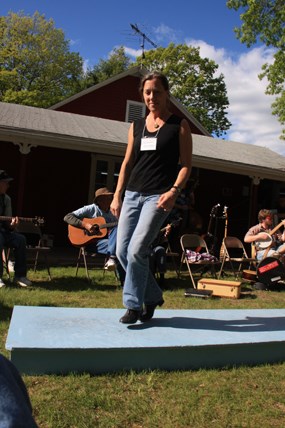
photo by Neal W. Traditional folk musician and dancer Aubrey Atwater will be in residence from May 29 – June 15, 2011. Aubrey started her musical career picking out “Here We Go ‘round the Mulberry Bush” on the piano at age five. She attended Brown University with studies in psychology, history, and French, while embarking on a performance career. Aubrey lives in Foster, Rhode Island, home base for her national and international performing dates, teaching engagements, and festival appearances. Her extensive travels also serve as field trips for researching traditional folk culture, history, music, and dance. Entwining a moving and humorous program of music and dance with stories from her life, Aubrey conveys folk culture as a fascinating expression of human history. Aubrey performs both solo and with her husband/collaborator Elwood Donnelly, as the duo Atwater-Donnelly. Atwater-Donnelly specializes in American and Celtic traditional folk music and dance. Together they have won numerous awards and produced eleven CDs and six books. Aubrey and Elwood, in turn, collaborate with eight other musicians and dancers, creating many exciting band combinations. Aubrey is self-taught on Irish tin whistle, Appalachian mountain dulcimer, old-time banjo, mandolin, and guitar, as well as American clogging and French Canadian “foot clapping.” Aubrey: “What job could be better than this? My business is joy, beauty, creativity, and the interpretation of nature and humanity. In modern society, traditional music and dance remind us of our deep and daily connection to nature and the marvelous human folkways that came before us. At Grand Canyon, I would like to meet people and learn from them while I am in such a unique and inspiring natural setting. In my artistic life, this is how I have learned my repertoire, to sing, dance, and play instruments. I like to soak up songs, stories, culture, and steps from people I meet in my travels. Every song and dance has such a back-story! I hope to connect with local Native American artists and exchange music, storytelling, and dance. And I’m open to any collaborative performance opportunities that may arise.” While in residence, Aubrey plans to present a performance at the Grand Canyon School. She will also offer an evening program of her folk music and dance at McKee Amphitheater and a family-friendly interactive dance and music workshop. She will spend her studio time meeting people and soaking up the canyon’s rich cultural diversity, as well as launch an ambitious solo hike into the Inner Canyon. 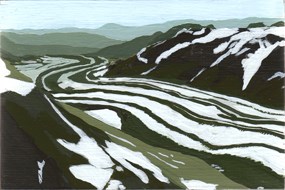
from American 101 series by Liz Roth Painter Liz Roth will be in residence from June 16 – July 9, 2011. Liz is an award-winning, nationally and internationally exhibited artist. She has been an artist-in-residence at the Wrangell Mountain Center (Alaska), Jentel Artist Foundation (Wyoming), the Awagami Paper Factory (Japan), the Kamiyama (Japan) Artists-in-Residence program, and the Vermont Studio Center. She has received numerous prestigious painting grants including the Wisconsin Arts Board Individual Artist Fellowship, the national Ludwig Vogelstein Foundation grant for painting, Oklahoma Visual Artist’s Coalition Grant 365, and OVAC’s Creative Projects Grant. Her works have been acquired by many national and international collections, including the Walker Museum of Art, the Museu del Joguet in Spain, the Museum of Awa Japanese Paper, and the KAIR Contemporary Art Collection. Liz is an Assistant Professor of Painting and Drawing at Oklahoma State University. Liz: “The advent of inexpensive, user-friendly cameras and particularly of point-and-shoot digital cameras results both in pleasurable images and (avoidable) visual overload. At virtually all tourist locations, most people replace the pleasurable and time-consuming activity of looking with the instantaneous and usually thoughtless experience of rapidly snapping photographs, often without even consulting the camera’s viewfinder. When I’m in these places I like to take the time to observe the other people there. I am absolutely astonished at how little time people actually spend looking at something amazing. People post unedited photos of their vacations online, not bothering to edit their choices, creating a mishmash of images that their viewer-friends repay with scant attention. While I use the camera as a tool to collect the images from which I create original paintings or drawings, for this project I will be primarily drawing on-site. With this work I hope to encourage people to take time to look when they take a journey. I seek to remind people of this simple and accessible pleasure”. While in-residence, Liz will present three evening program artist talk/slide shows about her United States-inspired, environmentally inclined paintings. Her own work will focus upon creating on-site drawings for a series entitled Overload. She will combine these small scale drawings into a large, gridded panorama of Grand Canyon. Displayed outside in a public place, this work will encourage both herself and park visitors to slow down and enjoy being here now. 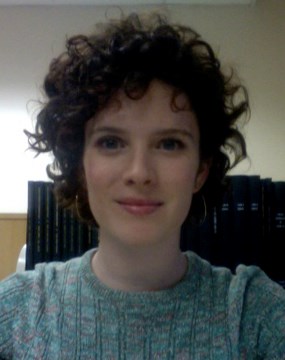
Poet Iris Cushing will be in-residence from July 10 – 31, 2011. Iris lives in Brooklyn, New York, where she is the web editor Columbia: A Journal of Literature and Art. She is also a co-founder and editor for Argos Books. Iris has her B.A. in Interdisciplinary Arts and Letters from Prescott College in Prescott, Arizona and her MFA in poetry from Columbia University in New York. Iris’ poetry and essays have won numerous awards, including first place for non-fiction in Alligator Juniper (High Above the Ground – 2009) and a Pushcart Prize Nomination (Transatlantic Telegram – November 2007). She’s been a writer-in-residence at Byrdcliffe Artists’ Colony in Woodstock, New York (June/July 2010) and received a one-year residency fellowship with the Frederick and Frances Sommer Foundation in Prescott, Arizona (2006). Her poetic collaborations with photographer George Woodman have been shown at Anderson Ranch Arts Center in Aspen, Colorado, as well as translated into Italian as part of an exhibition at Alessandro Bagnai Gallery in Florence, Italy. Iris: “Time spent in a particular environment inevitably has an effect on an individual, especially if she is sensitive to the particular rhythms of that environment. The Grand Canyon is a place that will be suited to a writing experiment using time and silence. Having spent four years in Arizona, I know that there is a particular silence that corresponds to the enormity of desert space, a particular way that thought moves through rock formations and chaparral. Although vast, the space is not empty, and neither is the silence. The Grand Canyon seems to be a place where silence and sound must co-exist in a way that can’t be found anywhere else. Sonic resonances between the stone, water and plant ecology are something I will explore in-depth through writing. I will accomplish this observation of the silence by taking my own vow of silence in gradually-increasing increments. My goal is to create poems that honor the coexistence of sound and silence, poems born in the wilderness, that are also a kind of wilderness themselves” While in residence, Iris will offer two all-age guided “poetry walks”, introducing participants through informal readings to some of the famous regional and historical writers whose work addresses the relationship between sound and silence. She will also offer an evening program reading of her work and discussion of her residency project. Her own project will focus on collecting observations from her quiet times along the rim and while hiking in the Canyon. Lois Frank at the Lost Horse Mine, Joshua Tree, California Improvised vase --- a bottle on the mantle. I remember the day we left town. Beans, soup Mountains plain and brown as ant-hills The miner I'd married, our children, myself, May's sun seethed on the sinewy plants. Coyote-squash ripened on the mine-side of the mountain: hollow spider webs. We lived on jackrabbit meat and wild grapes He disappeared in to the mineshaft each day, to pick Oil more rare than wood. Still, we cut our four chars up for the fire. The best part of our one-room house was the chimney. Smoke from the chimney's flue, My husband might've slipped, fallen on his pick Maybe a rattler bit me as I stooped to dig a root, By 1897 we were gone. The house dismantled; 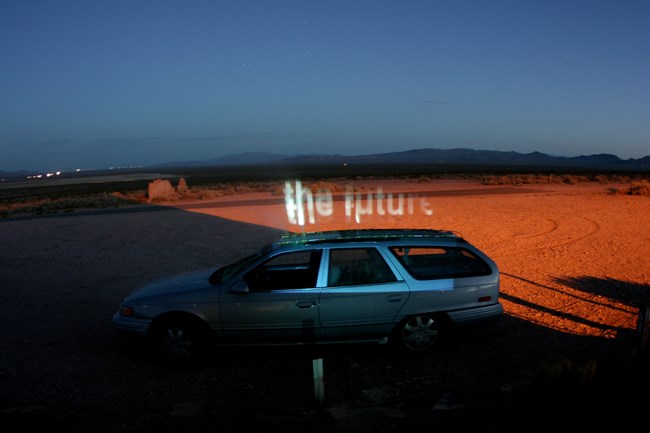
photographed near Death Valley National Park by Andrea Polli and Chuck Varga The August, 2011, artists-in-residence are married collaborators Andrea Polli and Chuck Varga, both sound and visual media artists. Andrea has her BA from Johns Hopkins University in Baltimore in art history and her MFA from the School of the Art Institute of Chicago in “Time Arts.” She has exhibited her solo and collaborative work extensively both nationally and internationally. Andrea has received an Artist’s Fellowship from New York Foundation for the Arts (2009), The Queens Council on the Arts Individual Artist Support (2008), a US National Science Foundations Artist’s and Writer Program in Antarctica (2007–2008), and an artist’s residency at the Taipei Artist Village in Taiwan (2006). Andrea was formerly an associate professor of Film and Media and the Director of the MFA program in Integrated Media Arts at Hunter College in New York, and is currently an associate professor of Fine Arts and Engineering at the University of New Mexico in Albuquerque. Chuck’s background is in art history and graphic design at the Virginia Commonwealth University in Richmond. He has an eclectic and exciting personal history of working on many large theater productions including script writing, production management, character design, large-scale creature costume design and fabrication, and stage set design. His projects involved rock and roll production (GWAR – 1985-1997) and puppet and costume fabricator for Blue Man Group, The Lion King, Where the Wild Things Are, Into the Woods, Spamalot and other shows. He also did design and fabrication of special effects for photography, film, and theater including Sweeney Todd and Cirque Du Soleil. Currently Chuck works as a scenic artist, sculpting and painting scenery for Broadway productions such as The Wedding Singer, Pajama Game, and for Disneyworld’s Cars (Pixar), to name but a few of his projects. Andrea and Chuck: “We have been creating artworks about environmental science issues since 1999, when we first began collaborating with atmospheric scientists on sound and data sonification projects. Since then we have created several major media projects in collaboration with scientists, including work about climate change. We are very interested in how artworks can impact individuals and communities and often work collaboratively to create projects that engage the community. Art often presents a personal interpretation of information. How does the personal expression aspect of art intersect with the uncertainties of weather and climate science? We have been focused on how art can play a vital role in understanding the science of climate and weather, through interpretations of the data and direct communications with scientists. Our residency focus will extend our on-going project Hello, Weather! into the huge and dynamic environment of Grand Canyon”. While in-residence, Andrea and Chuck will install a modified professional weather station that transmits wind speed and direction, temperature and relative humidity, solar radiation, rainfall and live sound and video to the web for real time presentation. They will offer “weather workshops” for park visitors which will engage visitors in their project and teach them about weather stations, how this becomes their art work, and how to interpret the data that comes from their equipment. 
Bristol Harbour part of the 'elevenminutes' sculpture series by Antony Lyons Sculptor and installation artist Antony Lyons is the September 2011 artist-in-residence. Antony is an Irish national who lives in Bristol, England. He has a science and design background, with an undergraduate degree in geology from University College, Cork, and a Masters in Landscape Architecture from the University of Greenwich in London. Antony uses sculptural materials (especially steel, vitreous enamel, and concrete) as well as video and photography. He works on large-scale public artworks and more intimate, long-term, explorations of place. His work often focuses on the idea of “creative transformations” involving landscape design, environmental, and land-art projects. He has a special interest in creating mixed-media pathways, trails and portals in public places with the idea of crafting mysterious routes that are grounded in both ancient and contemporary influences. Antony has participated in many residency and public art programs including the Leonardo/OLATS ‘Lovely Weather’ project in Donegal, Ireland; following in the footsteps of the romantic poets in Quantock Dreaming, Somerset, England; and waymarker installations for the Green Ribbons path network in Sheffield, England. This will be Antony’s first residency opportunity in the United States. Antony: “I remember a part of the Life on Earth BBC series from 1979, where narrator Richard Attenborough travels a vertical mile into Grand Canyon in search of fossil evidence of the earliest life. By the time he reaches the Colorado River bed, the geological strata are 2,000 million years old. In hindsight, this was one of the inspirations that led me to study my degree in geology some years later. A film made by the Kolb Brothers, Emery and Ellsworth, documenting their almost superhuman explorations of the Colorado River and the Grand Canyon also made a deep impression, as did images of panoramic photographs taken on the geological expeditions. I am keen to develop a personal creative response to these important archival records, to provide a contemporary perspective on some of the same sites, using the scientific references and aesthetic qualities of the original records. I plan on using a steadicam in the canyon, allowing me to bring a dream-like quality to some of my field recordings. My work will be a celebratory acknowledgement of the early pioneering achievements and geological investigations, but also form a contemporary imaginative exploration, creating a “deep mapping” profile of my time at the canyon. Antony will offer three lively and interactive evening programs, presenting his Grand Canyon work in-progress, as well as work from past completed projects. In residence, Antony will be both on the trails with his recording equipment and in the park archives and science center collecting images and inspirations for a final Grand Canyon piece to be completed upon his return home. Former Selected Artist in Residence (for reference): Selected Artists - South Rim - October 2014 - October 2015Selected Artists - South Rim - October 2013 - October 2014 Selected Artists - North Rim - 2013 Selected Artists - South Rim - 2012-2013 Selected Artists - South Rim - 2011 - 2012 Selected Artists - North Rim - 2011 Selected Artists - South Rim - 2010 - 2011 Selected Artists - North Rim 2010 Selected Artists - South Rim - 2009 - 2010 |
Last updated: September 28, 2016
